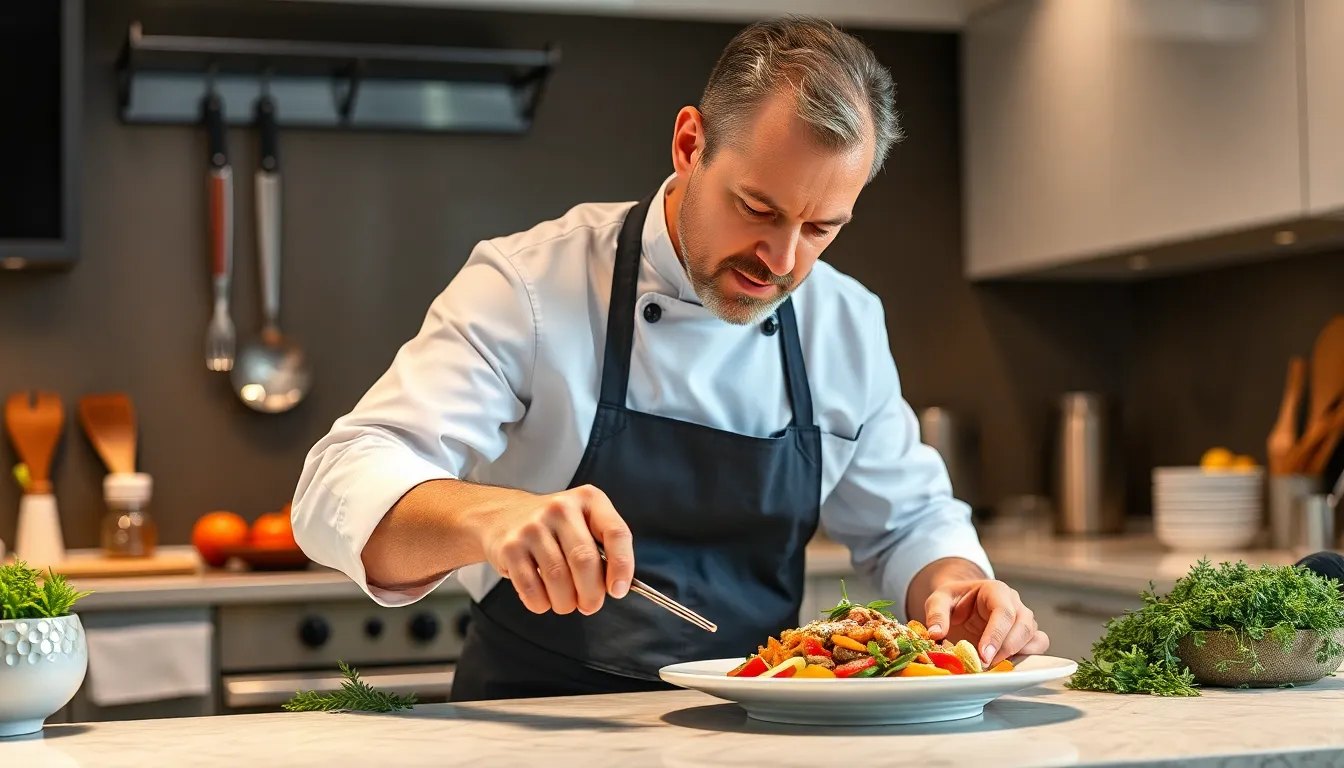Gourmet cooking isn’t just about throwing a few fancy ingredients together and calling it a day. It’s the culinary equivalent of a Michelin-starred performance, where every dish tells a story and every bite is a standing ovation. Imagine transforming your kitchen into a five-star restaurant, impressing your friends with dishes that look like they belong in an art gallery.
Table of Contents
ToggleWhat Is Gourmet Cooking?
Gourmet cooking signifies a refined approach to culinary arts that emphasizes high quality and presentation. This style relies on superior ingredients including rare spices, fresh herbs, and artisanal products. Chefs create visually appealing dishes that engage the senses and evoke emotions, much like a piece of art.
Attention to detail plays a crucial role in gourmet cooking. Each element, from flavor combinations to plating techniques, works harmoniously to enhance the dining experience. Chefs draw inspiration from diverse culinary traditions, merging techniques to create innovative, memorable dishes.
Seasonal and local ingredients are often preferred, reflecting a commitment to sustainability and freshness. Utilizing these components not only supports local economies but also encourages creativity in the kitchen. Chefs experiment with textures and flavors, ensuring every dish tells a unique story.
Presentation takes center stage in gourmet cooking. Dishes are meticulously plated to create an aesthetically pleasing experience that entices diners. Garnishes, color contrasts, and plate arrangements contribute to the overall look, making a meal resemble a carefully composed painting.
Gourmet cooking often requires advanced techniques and knowledge. Skills like sous-vide, emulsification, and fermentation may be employed to elevate traditional dishes. This level of mastery assumes a deep understanding of ingredients and cooking methods, ultimately distinguishing chefs who practice gourmet cooking from others in the culinary field.
Overall, gourmet cooking encapsulates an intricate blend of flavors, artistic presentation, and meticulous attention to detail, creating an unforgettable dining experience.
Key Ingredients in Gourmet Cooking

Gourmet cooking relies on a selection of high-quality ingredients that enhance flavor and presentation. Understanding these components elevates culinary creations.
Specialty Ingredients
Specialty ingredients play a significant role in gourmet cooking. These often include rare spices, exotic oils, and unique sauces. Truffle oil adds a rich flavor, while saffron introduces distinct notes to dishes. Artisanal cheeses and cured meats can transform a simple recipe into an extraordinary experience. Chefs select these ingredients to create a nuanced taste profile and showcase creativity. Utilizing locally sourced honey or handcrafted vinegars can deepen the connection to regional cuisines, making each meal a celebration of both taste and tradition.
Fresh vs. Processed
Choosing between fresh and processed ingredients impacts gourmet cooking dramatically. Fresh produce delivers vibrant flavors and essential nutrients. Chefs often prioritize seasonal fruits and vegetables for maximum freshness. Processed foods, however, can offer convenience and consistency. High-quality processed items, like gourmet canned tomatoes or imported olive oils, still deserve a place in many kitchens. Balancing fresh ingredients with carefully selected processed options allows for flexibility in upscale recipes. It’s essential to assess each ingredient’s quality to maintain the integrity of gourmet cooking. Using fresh herbs alongside artisanal spices guarantees complex flavors and an impressive presentation.
Techniques Used in Gourmet Cooking
Gourmet cooking relies on sophisticated techniques to elevate each dish. Mastery of these approaches enhances both flavor and presentation.
Sous Vide
Sous vide involves vacuum-sealing food in a bag and immersing it in a precisely controlled water bath. This method allows for consistent temperature control, ensuring even cooking throughout the dish. Ingredients retain moisture and flavor, resulting in tender textures that traditional cooking methods might compromise. Chefs often use sous vide for proteins like steak, poultry, and fish, achieving perfect doneness while enhancing the overall taste. Many combinations benefit from this technique, including vegetables cooked to retain their vibrant colors and nutrients.
Plating and Presentation
Plating and presentation play a crucial role in gourmet cooking. Visual appeal influences the dining experience, as an elegantly arranged dish stimulates anticipation. Chefs employ various techniques, such as stacking, drizzling sauces, and utilizing height to create dynamic compositions. Color contrast enhances aesthetic value, making the dish more engaging. At times, edible flowers or microgreens provide visually striking accents. Texture also matters; crunchy elements can add interest to otherwise soft dishes. Well-plated food resembles a work of art, transforming a meal into an unforgettable experience.
Popular Gourmet Dishes
Gourmet cooking showcases a variety of exquisite dishes that highlight creativity and quality. These dishes often elevate dining into an art form.
Classic Gourmet Dishes
Classic gourmet dishes include well-known favorites like Beef Wellington, Coq au Vin, and Lobster Thermidor. Beef Wellington features tender beef enveloped in flaky pastry, often complemented by mushroom duxelles and prosciutto. Coq au Vin involves chicken braised in red wine with aromatic vegetables and herbs. Lobster Thermidor presents tender lobster meat in a creamy sauce, baked until golden and served in its shell. Each dish exemplifies a combination of rich flavors and artful presentation.
Modern Innovations
Modern gourmet innovations play with traditional recipes while incorporating contemporary techniques. Sous-vide cooking allows flavors to develop in a precise temperature-controlled environment, creating perfectly tender meats. Deconstructed dishes challenge conventional presentations, inviting diners to experience familiar tastes in new formats. Unique flavor pairings, like whipped foie gras with fruit gelées, engage the palate and spark curiosity. Enhanced plating techniques, such as edible garnishes and vibrant sauces, turn meals into visual experiences. These innovations reflect a forward-thinking approach while honoring culinary tradition.
Gourmet Cooking at Home
Gourmet cooking at home transforms everyday meals into memorable dining experiences. It emphasizes using high-quality ingredients and artistic presentation. Fresh herbs, rare spices, and artisanal products play crucial roles in this culinary approach. Chefs engage in flavor harmonization, ensuring that each dish tells a unique story.
Seasonal and local ingredients take precedence, supporting sustainability and offering a chance to experiment with flavors. Techniques like sous vide and fermentation allow home chefs to explore sophisticated methods while retaining ingredient moisture and enhancing textures. They can create visually stunning plates that resemble artful creations.
Examples of popular gourmet dishes, such as Beef Wellington and Lobster Thermidor, showcase the ultimate in flavor and aesthetics. Modern innovations enhance these classics, inviting creativity in both technique and presentation. Deconstructed dishes present familiar tastes in unexpected ways, engaging diners through unique flavor pairings.
Attention to detail ensures each dish captivates and impresses. Thoughtful plating elevates meals from the kitchen table to a restaurant-quality experience. Diners appreciate both taste and visual appeal, creating a complete culinary experience at home. By mastering these elements, anyone can elevate their home cooking into the realm of gourmet cuisine.
Gourmet cooking is an art form that transforms the ordinary into the extraordinary. By embracing high-quality ingredients and refined techniques, anyone can elevate their culinary creations. The emphasis on presentation not only enhances the dining experience but also invites creativity and innovation in the kitchen.
With a focus on seasonal and local produce, home chefs can craft dishes that not only taste exceptional but also tell a story. Mastering sophisticated methods like sous-vide and fermentation opens new avenues for flavor exploration. Ultimately, gourmet cooking offers a rewarding journey that encourages both skill development and artistic expression, making every meal an opportunity to impress and delight.



